Urban Archaeology
UPS dropped a large box on my doorstep without asking for the requested signature from the sender, a New York City American Indian arts dealer. It didn’t matter because within moments I am excitedly bringing the antique Acoma olla into my kitchen for excavation from its shipping cocoon.
The age of this pottery is thought to be circa 1890-1900, it is a four-color polychrome design, with wear from use as a water vessel, now something very difficult to find. As I open the box, within a box, and begin to unravel bunches of bubble wrap, I finally arrive to the final tissue, screening me from seeing my new treasure. It’s like urban archaeology. Soon the soft orange color, and earthy red are revealed. I peel away the white protective tissue. I think of Sipapu, the place of emergence associated with the Acoma creation story.
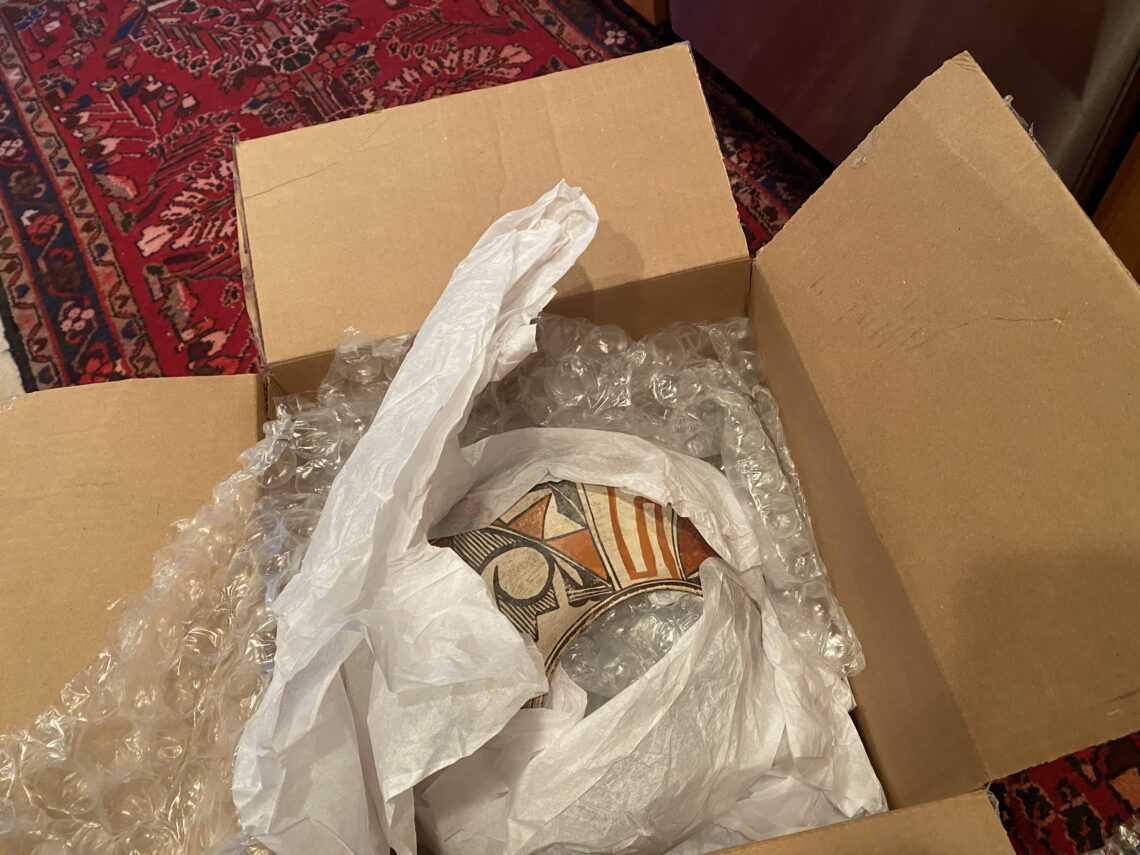
The first moments of unpacking are the most nerve-wracking. Did the pottery make it one piece? Is it even more beautiful in person, than in the photos on-line? What is the real condition of the piece? Is it what the dealer said? Can I really see the artists original design lines, changed at the moment of creation, in the red section?
I’m fortunate. The piece is even more beautiful than I imagined. There is emotion in the work, and the design is unique. There is an unusual softness to the patina from serving as a vessel to hold water—its intended use— and the many decades of interacting with humanity.
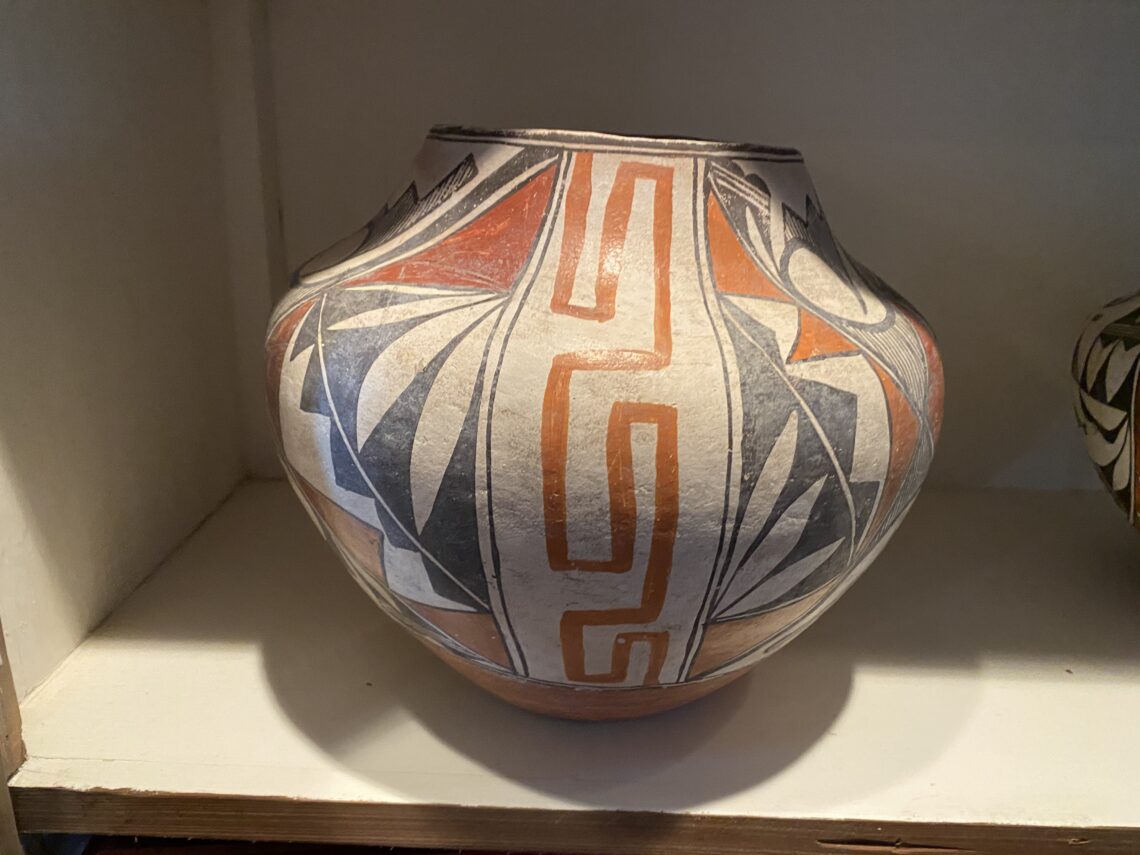
Enthusiastically, it joins others in my collection. They feel good together, they look good in our home, and I feel honored to have them in my life. They feel important. I walk around the room viewing the rustic vitrine where the new pottery is displayed from different vantage points, different lighting, and I am filled with a sense of gratitude. For several days, every pass through the room, the pot is flirting with me, and I with it, with stream of conscious rumination about their beauty, the culture, and their place in history. Why have I never researched, or written about these amazing women who made these? What was happening in 1890-1900 in New Mexico, or even before that to shape these artists?
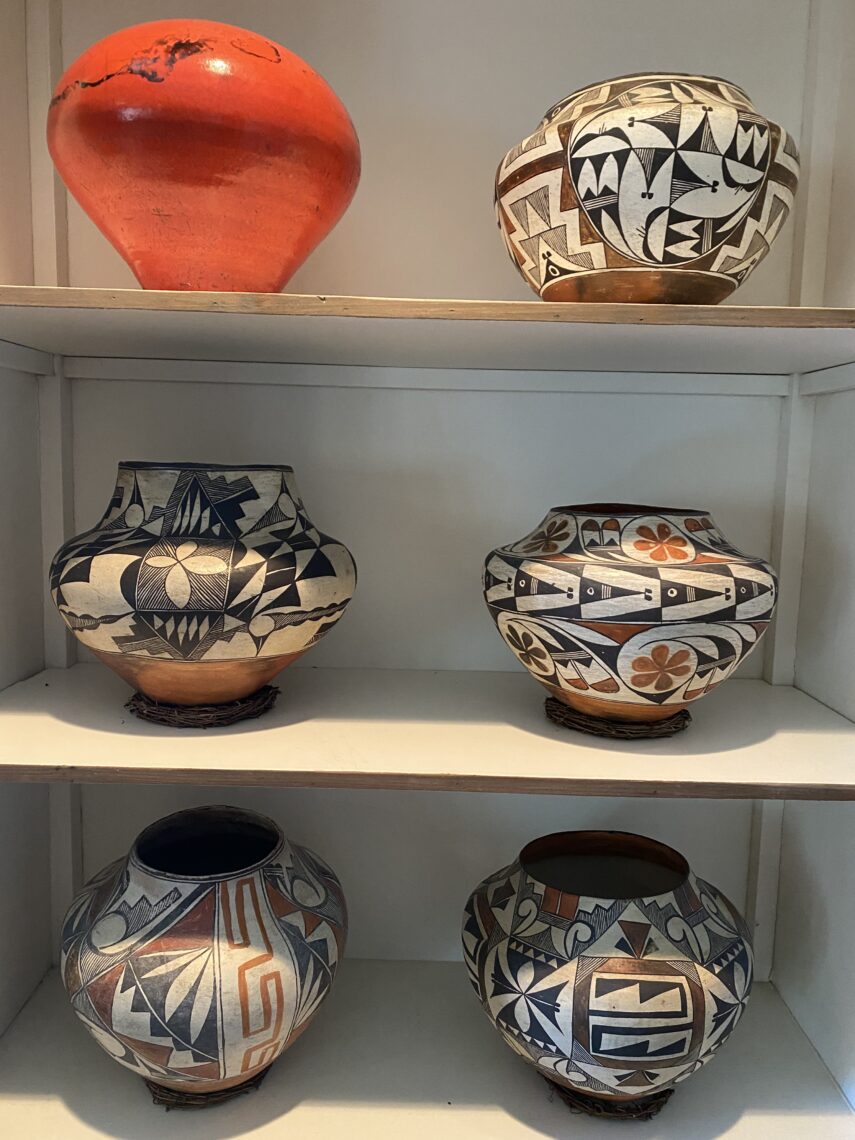
This inspires me to inspect each pot carefully: noticing slight design imperfections, discoloration in the clay from firing, a leaning form in some, worn surfaces in places, inner scrap marks, the fading patina of the aging white slip, the rough marks on the bottom from when the potter lifted it out of the huudiitsi, and the lovely ringing sound when you thump the side—all proof that they were authentically handmade, one-of-a-kind, and painted by an Acoma artist.
As I handle the pottery, I’m inspired to know more of what shaped these amazing people who gave the world this utterly original art. It’s unsettling to think that I have an undergraduate degree in history, and have studied art for forty years, owned a home in New Mexico, have visited the Hopi reservation, the Taos reservation, but had never visited Acoma. I know almost nothing about what the New Mexico tourism industry calls the Acoma Pueblo’s, “Sky City, ” and what the native people call Haak’u, “A place prepared.” It is the ancestral home of the Acoma. A place that outdates this country’s national identity by almost five times, and a place that Acoma families have continuously lived for over 1,000 years. I was never taught about this place in school, nor Oraibi, a Hopi village with equal longevity and cultural significance.
Today, Acoma Pueblo reservation is 900 square miles of land, and has a population around 5,000 people. However, only about 30 people actually live atop the mesa. There is no running water or plumbing, nor cellular phone service. Residents always mention the quiet, and when you hear the Acoma people communicate, it is with a lovely ease and gentleness of spirit.
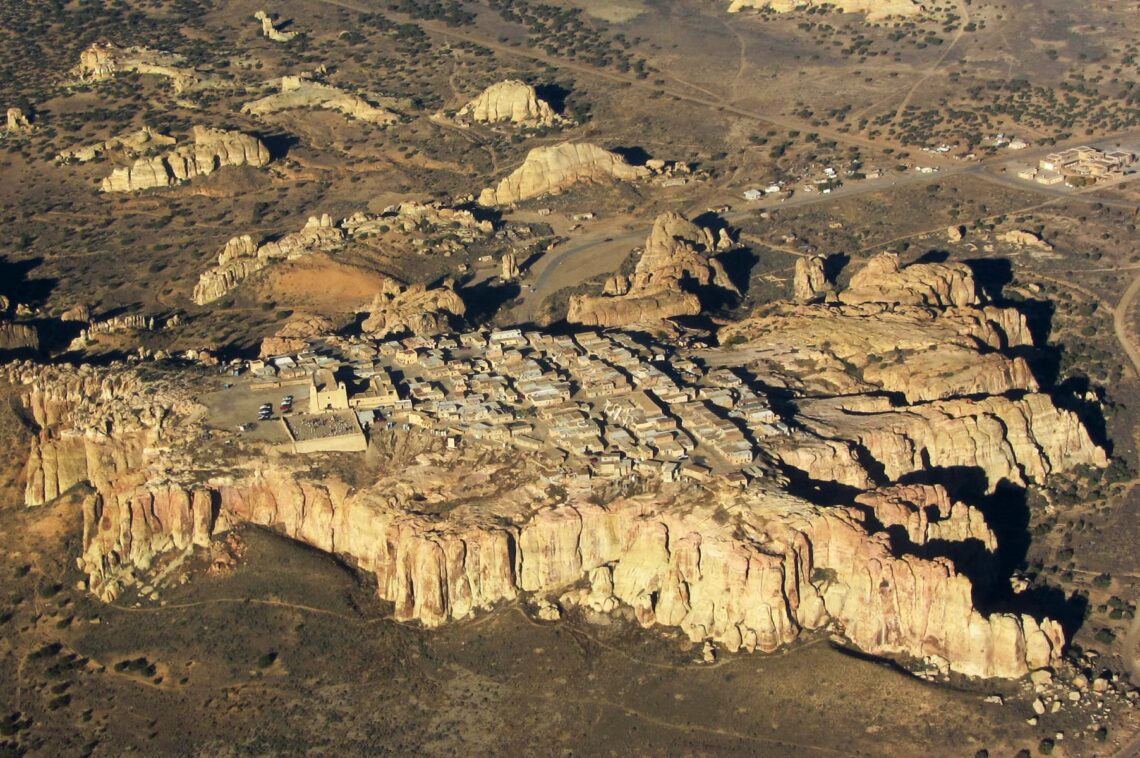
As you can see, the pueblo is high atop the mesa, 365 feet, and offers an incredible view of the surrounding landscape which features all the elements needed to make the beautiful work that is so distinctly, Acoma pottery. To the north is their sacred mountain, Mt. Taylor. To the east, are their neighbors, the Laguna Pueblo. To the west, the Zuni Pueblo, and Zuni Trail through what the Spanish named El Malpais. It has a pygmy forest and America’s oldest Douglas fir, thought to be alive since A.D. 719. Some of these groves were already standing long before Spanish conquistadors first arrived to the area in search for gold.
Sipapu
Sipapu for the Pueblo people is the place of emergence. It is the place where their ancestors came from the world below, and entered the light, and conditions of this world. I will not tell the creation story in this discussion because there are many versions, and I feel like it would be inappropriate for a non-native to share this story without coming from the culture, and speaking the language.
However, in general, it explains the intricate relationship with man, animals, and their intimate and absolute connection with the natural world. This is the cornerstone, and the fundamental requirement, if anyone is to try and truly understand any Native American culture.
Further, it illuminates the extraordinary and antithetical difference between native people and the Europeans: who came to conquer and subjugate nations of tribes, using torture, murder, enslavement, and forced enculturation for personal, and later, “national” gain—all done in the name of Christianity.
The exacting historical attacks and challenges on the Acoma pueblo over the last 400 years leaves one to consider just how a people so inflicted with adversity could possibly produce such extraordinary works of art, and have the wellspring of strength to create them and share them with others. Only in the spirit of utter respect will I try to share some of the more obvious challenges historically, and how certain events might have had important influences on the people culturally and artistically: an intrinsic crucible.
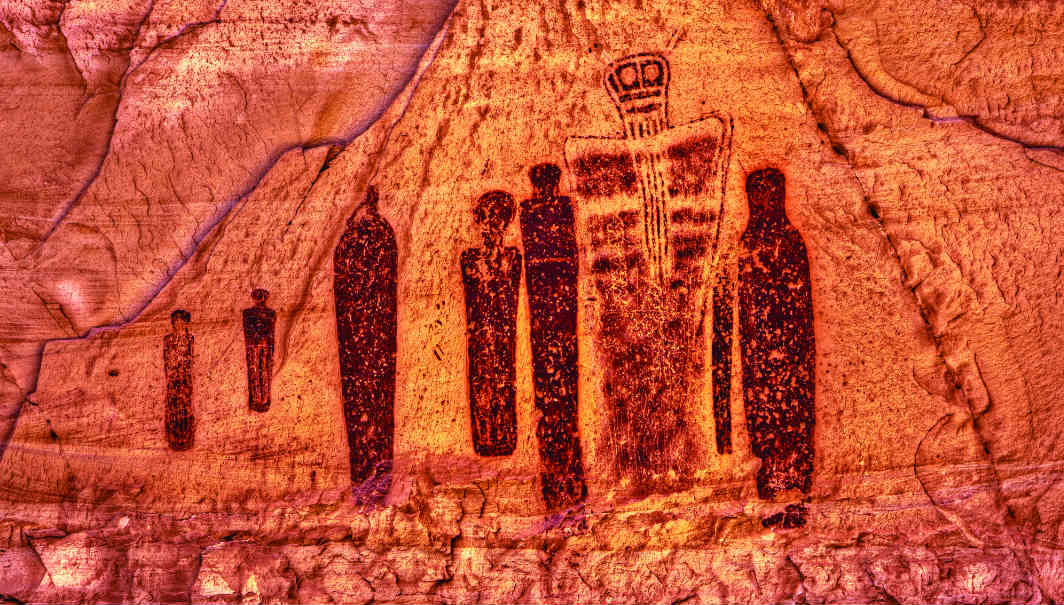
Ancestral Pueblo
Today, there are 100 inhabited pueblos. Acoma and Hopi are the most well known outside of the Southwest, I would argue due to their continued traditions of pottery making and their tremendous success, with historic key artists such as Nampeyo of Hano (Hopi) and Mary Histia (Acoma). Traditionally, they are joined by common ancestry, religious practices (Kivas and Kachinas), and farming.

It is certain that many of the Pueblo people are the descendants of the Ancestral Puebloean people that so many refer to as the “Anasazi.” According to archaeologist Linda Cordell, “Anasazi” was first used in relationship to the ruins of Mesa Verde by Richard Wetherill, a rancher and trader, who was the first European-American known to explore the sites in that area in 1888–89. The term is of Navajo origin and means, “ancient enemy.”
The name was further established in 1927 through the archaeological Pecos Classification system, referring to the Ancestral Pueblo people who spanned the present-day Four Corners region of the United States, including: Mesa Verde, Chaco Canyon, Canyon De Chelly, and Aztec. Mesa Verde, for example is thought to be inhabited circa A.D. 705, and ending in A.D. 1200.
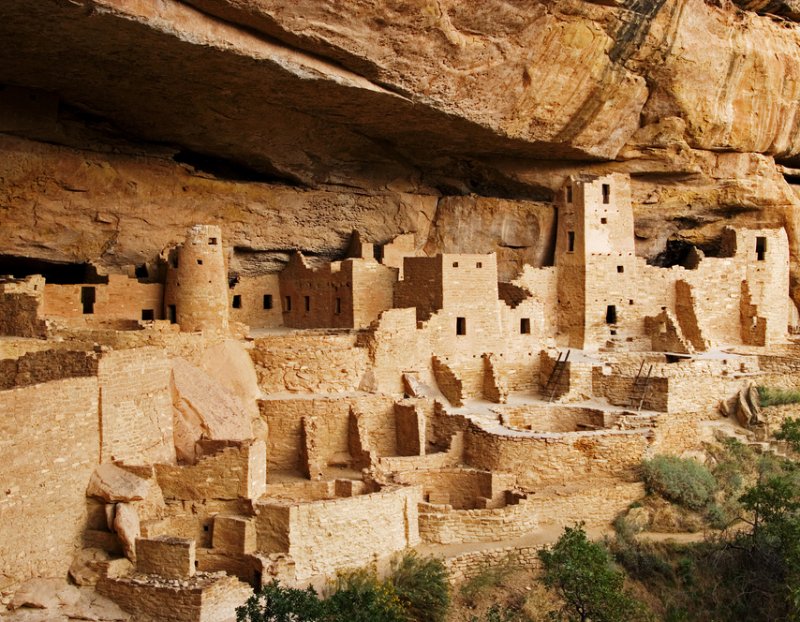
The people we call the Acoma today, were the descendants of the Ancient Puebloan people that also made amazing pottery, as well as other groups: the Mogollon, Hohokam, Patayan, Fremont. The earliest inhabitants are called the “Basketmaker People,” and they began making pottery in about B.C. 300 in Arizona, and circa A.D. 400-500 in New Mexico. They discovered that pottery took less time to make than baskets, and aided in storage, cooking, and other utilitarian uses. It was also more effective to protect against rodents.
The entire area we call the “Four Corners,” where Utah, Arizona, New Mexico, and Colorado meet, including areas in Texas and Northern Mexico, have many fascinating historic variations in style and materials that archeologists continue to study.
Weather and war are the greatest known causes of ancient migrations in the region. What is certain is that there was a great deal of movement and trade, with groups as far south as Central Mexico and the coastal Pacific, and to the north with the Plains Indian tribes.
Spanish Arrivals in the Southwest
Christopher Columbus never once set foot on the soil we call the United States of America.
It is important to point out that the first European arrivals to the Southwest was a small band of shipwrecked Spanish castaways, who were battered by a storm in Florida, and then again on the Texas Coast, around Galveston, and were led by Cabeza de la Vaca. After a tough winter, with most of his 80 men dead, he was captured by natives for three years, and then literally walked back to Mexico City from Galveston, which took eight years by the time they arrived in 1536. During this arduous trek, he and his few trusted survivors would have first encountered the Pueblo people on his return to “New Spain.”
One of his crew castaways was an Arab speaking African Berber Moor, named Mustafa Azemmouri, or “Estevanico” (Little Steven). Then, a Spanish slave, he was captured by the Portuguese, and sold to a Spanish nobleman in 1522. Spain didn’t allow non-Catholics to travel to the New World, thus most historians believe he would have converted to Catholicism, and was given the Christian name, Estèban.
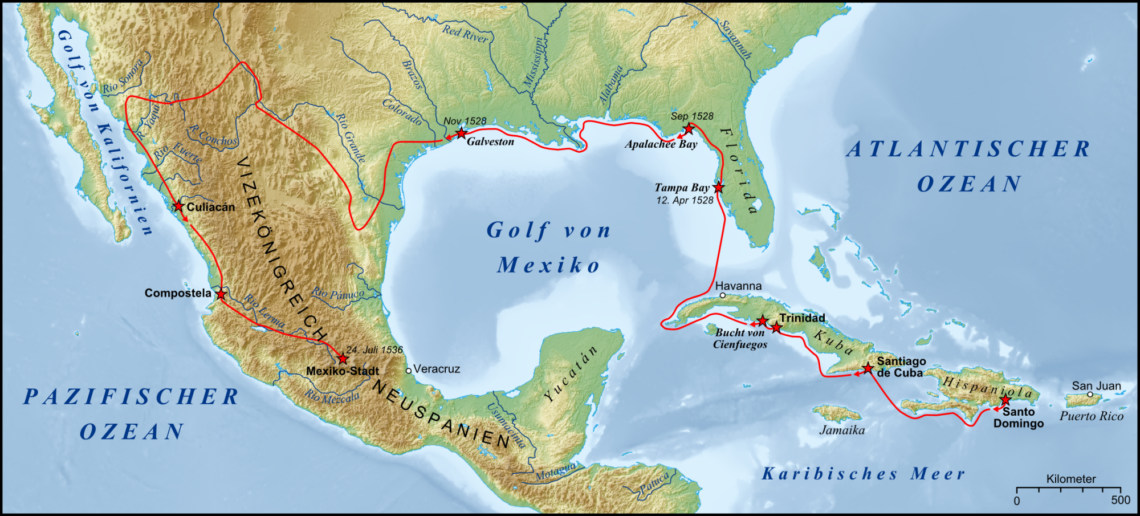
Estèban would become a scout and something of a diplomat, often making the initial contacts with new tribes along their route, and acting as the lead communicator because of his noted skill for quickly picking up new languages and using effective sign language.
In 1531, Father Marcos de Niza led an expedition north, to the Southwest, based on the earlier reports of De la Vaca. He brought Estèban to be his chief negotiator with the Native people.
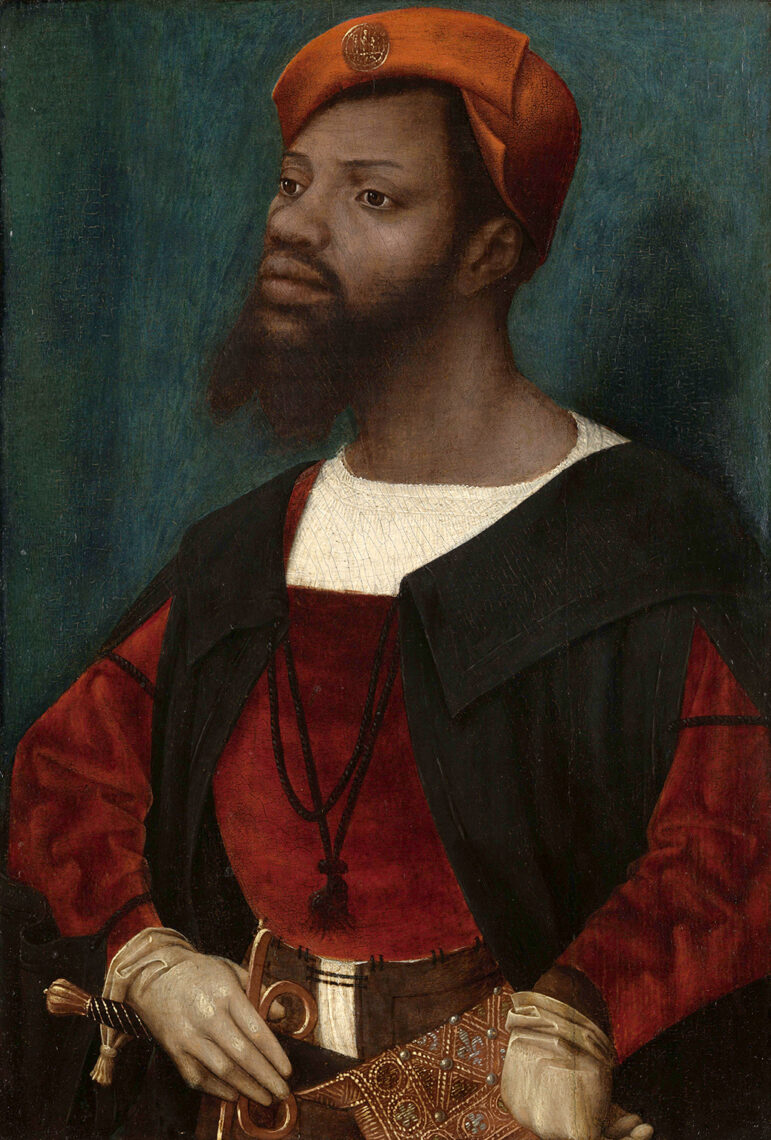
Estèban went ahead of the convoy and arrived to a pueblo village called Háwikah, which later the Spanish would name, Zuni. Niza received word from Estèban that he had discovered a very large village, but when he arrived to the area, Estèban had already been killed. Niza claimed to see the “Seven Cities of Cibola” in the distance, and exaggerated the riches, inspiring Francisco Vasquez de Coronado to launch a very deadly campaign into the Southwest.
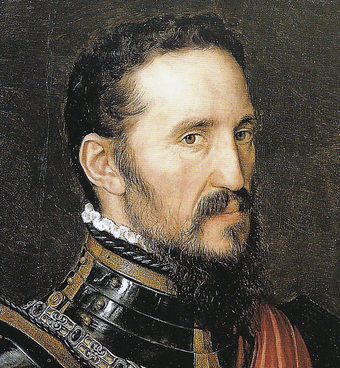
When Francisco Vasquez de Coronado arrived to Acoma in July of 1540 in search for gold, it is said that the Spanish arrived during a midsummer solstice celebration and the Acoma had placed a line of cornmeal at the entrance which Coronado interpreted as an act of defiance, and “laid siege” and captured the village.
Personally, I doubt this is what happened. This sounds like “politically correct” vindication on the part of the Spanish, to downplay the Spanish brutality. By the time they arrived to the Southwest, the conquistadores had already been in the Americas for 48 years, and had conquered the Aztecs in Mexico and the Incas in Peru, killing, torturing, and subjugating them to extract gold and silver. These were not Spanish Boy Scouts!
Since the arrival of Columbus, the Spanish rationalized their invasion by classifying the natives as “uncivilized and savage.” They treated them harshly and without real justification. The Spanish demanded a “tribute” paid from the Indians in gold. If they failed to pay, they might be forced to work, tortured, killed, or a foot chopped off. Of course, violence, torture, and conquest were very much a holy trinity of the European DNA at the time.
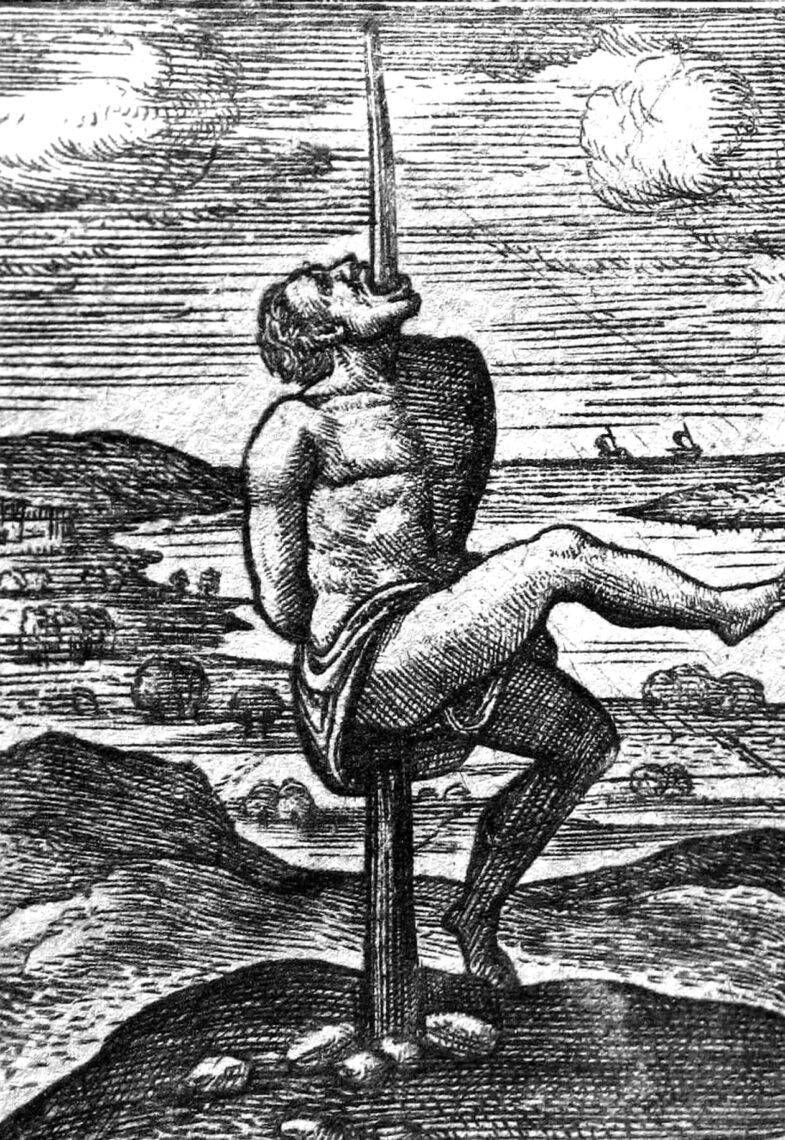
The Spanish priest, Bartolome de Las Casas (1484-1566) wrote:
“ . . . Our Spaniards have not more consideration for them [the natives] than beasts. And I say this from my own knowledge of the acts I witnessed. But I should not say ‘than beasts’ for, thanks be to God, they have treated beasts with some respect . . . In the beginning the Indians regarded the Spaniards as angels from Heaven. Only after the Spaniards had used violence against them, killing, robbing, torturing, did the Indians ever rise up against them.”
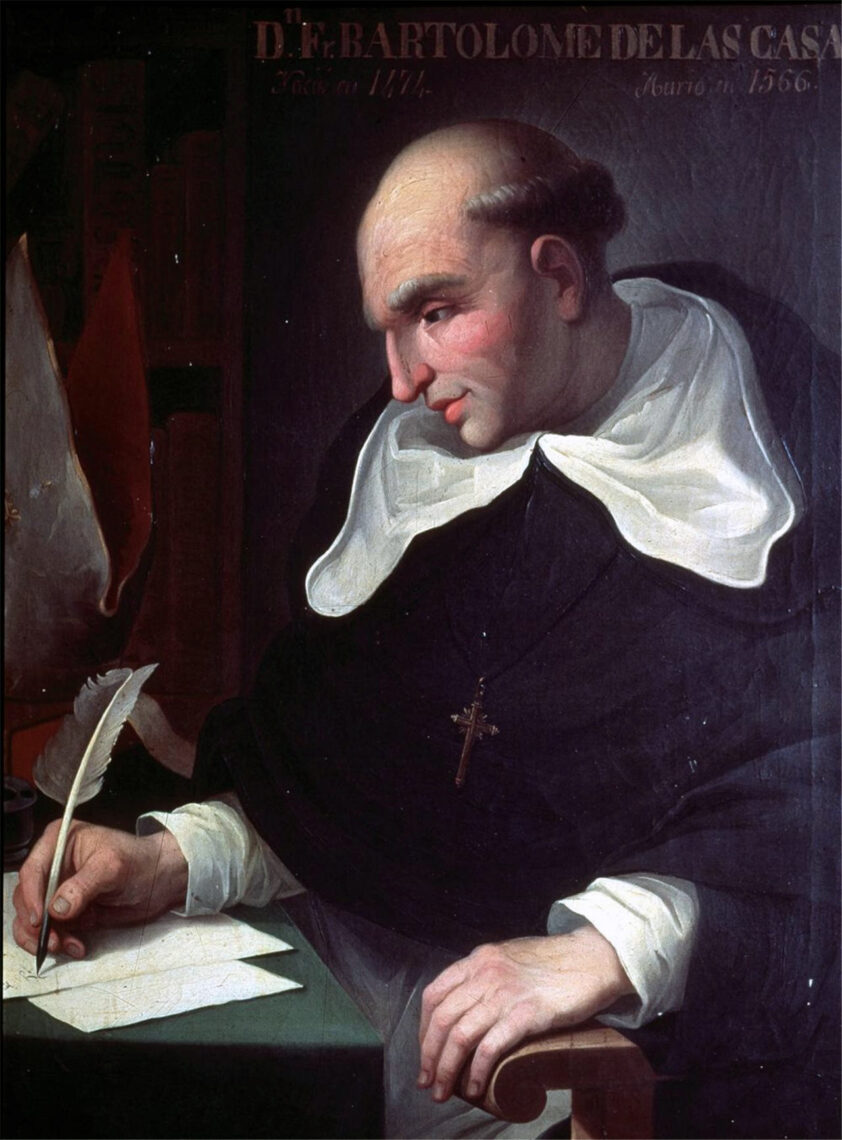
There seemed to be a consistent weave of contradiction in the Spanish invaders as tightly woven as any Navajo wool rug: Be a Christian beholden to God, loyal to the Crown, and acquire wealth from any source possible, by any means necessary. Certainly this mind-set was promulgated by the Spanish monarchy: still very much instigating the Spanish Inquisition (1498-1834), determined to root out heretics, and force the religious conversion of Jews and Muslims.
Forty years after Coronado left Acoma, new Friars arrived to the area. Comments found in one of their journals are revealing about the quality of Acoma pottery and the industrious nature of the people, and as well as evidence of the Spanish opinion that the natives were savages (a psychological pre-requisite if you want your men to fell absolved of their sins, and entitled to torture and kill natives if they don’t execute your will):
“…Houses very well planned and built in blocks, with mud walls, whitewashed inside and well decorated with monsters, other animals, and human figures…. The inhabitants have a great deal of crockery…all decorated and of better quality than the pottery of New Spain… These people are handsome and fair-skinned. They are very industrious and the best craftsmen in New Spain… For barbarous people the neatness they observe in everything is very remarkable.”
New Spain
In 1595, the year Shakespeare first performed Romeo and Juliet, Juan de Oñate, the new colonial Governor of Santa Fe, arrives to found a permanent Spanish colony. Oñate was married to Isabel de Tolosa, the granddaughter of Hernán Cortés, who toppled the Aztec Empire, and the great-granddaughter of the former Aztec Emperor, Montezuma. He also brought 129 soldier-colonists with their wives and children, and ten Franciscan Friars. The Franciscans sole responsibility was to convert the Acoma people to Catholicism.
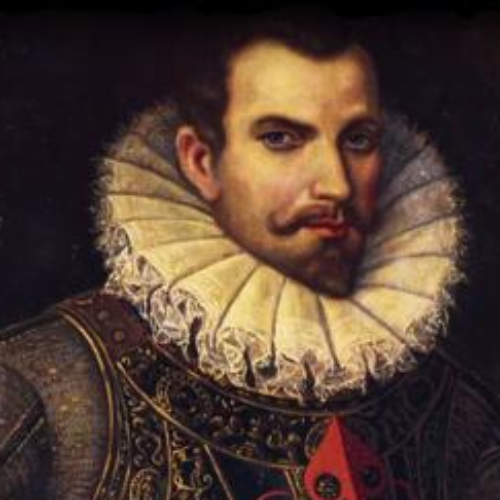
They came byway of The Camino Real, a route from Mexico City to Santa Fe, that allowed the Spanish to conduct trade, orchestrate human trafficking, promote settlements, move military assets, conduct commerce, and exercise political control.
Soon after Oñate’s arrival, the so-called, “Acoma Massacre” occurred. Oñate and his men launched an offensive that resulted in the deaths of around 500 Acoma men and 300 women and children killed in a three-day battle.
In February 1599, it is said that the victorious conquistadores delivered a brutal sentence:
• All men over twenty-five had one foot cut off.
• Males 12-25 were sentenced to 20 years of servitude.
• Women over 12-years-old must submit to 20 years of servitude
Conditions did not improve for the Acoma or Pueblo people under Spanish occupation. The Spanish and clergy placed very high demands on the Pueblo People: forced labor, servitude, and incomprehensible punishments for natives practicing their own religious ceremonies, which in those days were vast in number. They filled sacred kivas with virgin sand and built their own churches on top, forcing the natives to travel miles to carry the trees required to make the vigas (wooden beams) to construct the churches, and their homes.
In 1680, all the Pueblo people, including their old enemy the Apache, had enough of the abuses, and banded together to drive the Spanish out, which they succeeded in doing in what is today called the Pueblo Revolt of 1680.
For the next 12 years, the Pueblo People had peace, but soon afterward the Spanish returned by orders of the Viceroyalty of New Spain, followed by the Mexicans after Mexico gained Independence in 1810. This marks a pivotal point of outside influence in Acoma pottery design because newly arriving settlers, not wanting to risk transporting it over the Camion Real, would commission Acoma potters to make all of their needed dishes and serving wares. This would have most certainly come with instructions, and aesthetic preferences that profoundly influenced the potter’s aesthetic style.
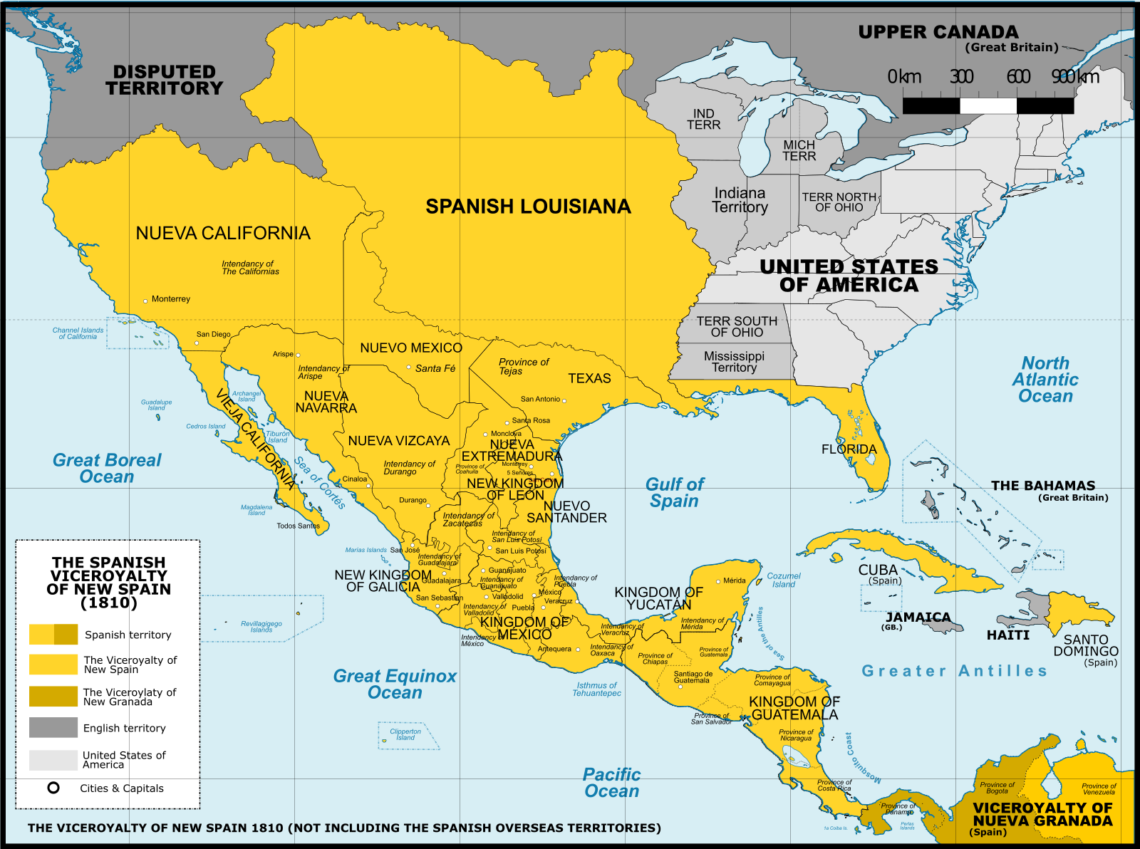
Santa Fe Trail
Beginning in 1821, the Santa Fe Trail opened way for European traders to bring manufactured goods from Missouri to the Southwest, both to settlers and Pueblo people alike. The United States was newly experiencing their Industrial Revolution; enabling the possibility to buy metal manufactured goods in the Southwest, often replacing certain traditional pottery wares used by the Pueblo people for centuries. For example, using a metal cast iron stew pot in lieu of a ceramic pot.

The trail connected in Santa Fe with the Mexican Camino Real, permitting one of the first commercial international trade route for American products.
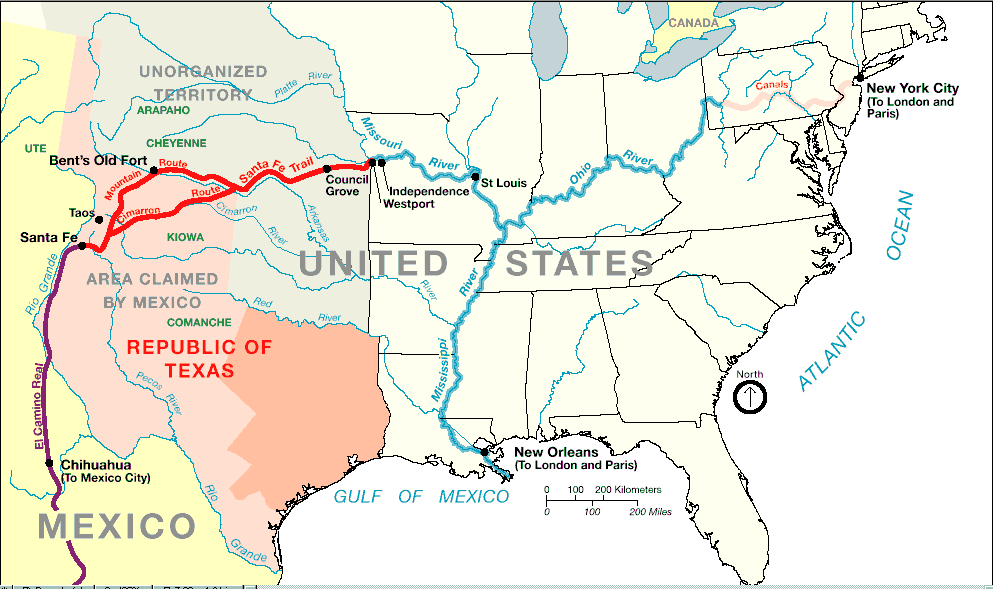
1848 United States Territory
The Treaty of Guadalupe Hidalgo in 1848 would forever change the lives of the Pueblo people, who had already suffered so dearly under the Spanish. They were overtaken by a different kind of cultural invasion, yet others in search for riches—The Americans!
Over the next twenty years, waves of Americans began arriving to the Southwest, cattle from Texas came in, and archaeologists bringing the Smithsonian Institution and Museum of Natural History who sent anthropologists to “study the Indians.”
[Sidebar: Later, in 1879, the Bureau of American Ethnology (BAE) arrived from Washington, a division of the Smithsonian Institute. They focused especially on acquiring old material and objects used in religious ceremonies, which they believed to be more “authentic” and untainted. They bought up family heirlooms on the Pueblo.]
In addition to social scientists, soldiers, new forts, and former Civil War veterans who wanted a new start. It also brought gold prospectors, ranchers, and outlaws.
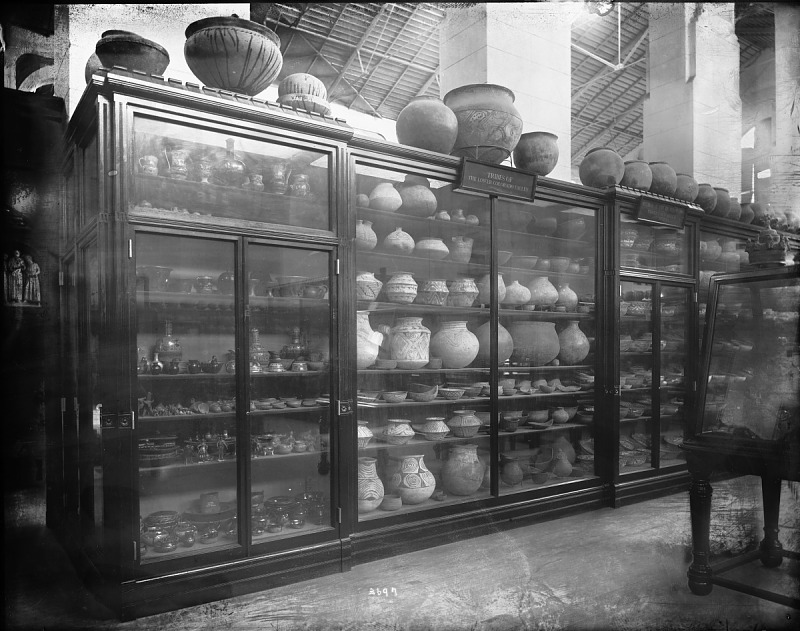
This must have been terrifying to the Pueblo people, who would have certainly heard by then news about what had happened to the native people living in the American Southeast, in The Georgia Gold Rush of 1830: which inspired President Andrew Jackson—a prospecting enthusiast—to sign into federal law, The Indian Removal Act of 1830. This legislation essentially removed all Native Americans from the entire Southeast of the United States. Most of you will have heard of the “Trail of Tears,” the name given to the Cherokee tribe’s forced march, but in all, there were 30 independent tribes forced to move to Oklahoma, to the most undesirable land in The United States of America at the time.
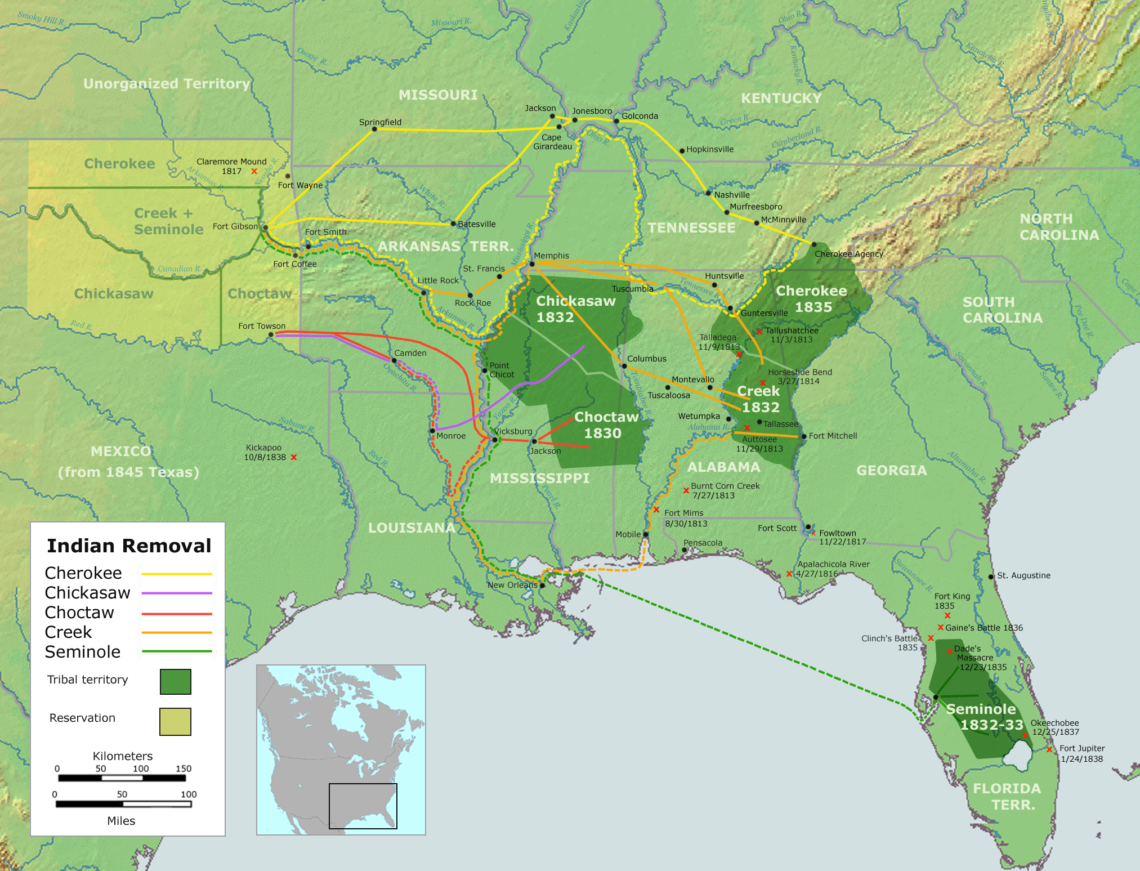
Much of the Pueblo territory, including Acoma land, was acquired by the United States in 1848 when we won the Mexican-American War (1846–48; a war fought between the United States and Mexico which led to loss of about one-half of Mexico’s national territory to the United States).
The Gold Rush of 1849 in California brought even more folks west to try their luck at prospecting for gold.
Gadsen Purchase
In 1853, President Franklin Pierce sent James Gadsden to Mexico City to negotiate with General Santa Anna for the United States to buy the remaining southern strip area of almost 30,000 acres, including both Arizona and New Mexico for $10 million. The purchase provided the land necessary for a southern transcontinental railroad.
Now part of the United States’ jurisdiction, the Federal Government established Fort Defiance in 1851 to deal with the Navajo threat to the Hopi people who occupied a pueblo on three mesas much like the Acoma, with an equal longevity of occupation in the region. The Apache and Navajo had long been Pueblo adversaries, and raided both the settlers, and the pueblo people.
General James J. Carleton, with the assistance of Kit Carson, was assigned to travel through the area. They “captured” the Navajo natives and forced them to the fort, and then forced another re-location, called the Long Walk of the Navajo. Some 53 different forced marches occurred between August 1864 and the end of 1866. Some anthropologists claim that the “collective trauma of the Long Walk … is critical to contemporary Navajos’ sense of identity as a people”. How could this not bring terror to all the Pueblo people, whom certainly would have lived with the fear that they could be next!
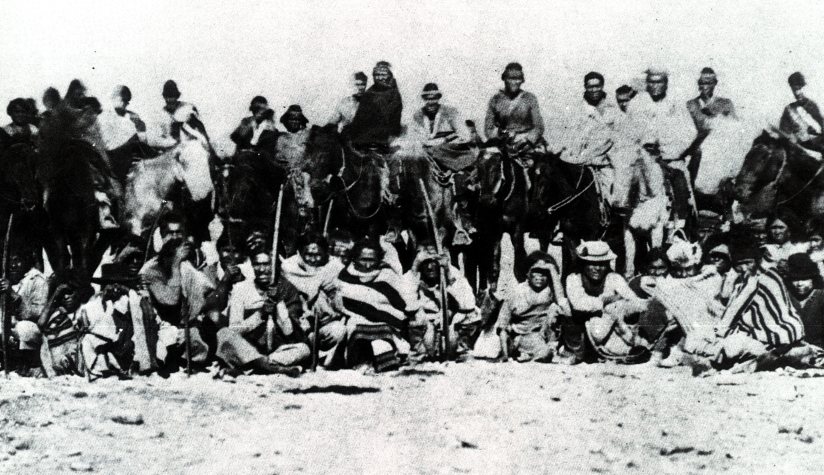
Pueblo Lands
In 1850s, the Federal Government, through the Office of the Surveyor General, established the boundaries of the Acoma Pueblo. Out of the more than one million acres found by the Indian Claims Commission, the Acoma grant was approximately 95,00 acres of high desert with limited water resources.
Between 1887 and 1934, the Federal Government took nearly two-thirds of reservation lands from the tribes without compensation. The trust process was subsequently created as a tool to help tribes regain original land bases. The tribes, subject to certain federal restrictions, govern the use of trust lands and the land is usually not subject to state laws.
Starting in the 1940s, Acoma litigated and petitioned the United States Indian Claims Commission for millions of acres of territory, reserved for the tribe in colonial land grants but disregarded by the United States. In 1970, Acoma received a financial settlement for its losses, but no actual land.
Iron Horse
The arrival of the Santa Fe Railroad in 1880 would ensure the amusement and fascination of eager tourists to experience and see “real Indians” before they all vanished.
Acoma pottery artists walked, or used a cart and donkey to bring pottery to the Laguna train station to sell pottery to travelers, often right from their window on the train! If you have ever been in sales, you know that one quickly learns how to discern and emphasize manufacturing by what “sells!” This new transit market place would have a big impact on the Pueblo Arts.
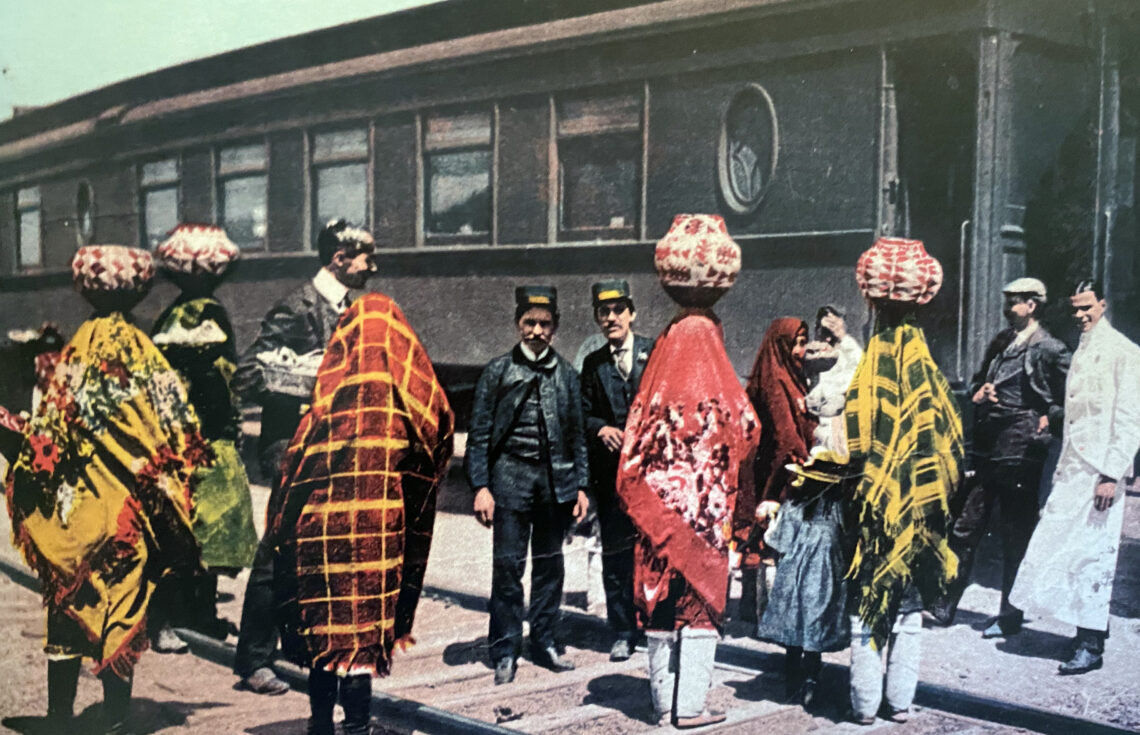
Mr. Big
A very industrious young man named Fred Harvey, born in London in 1835, began working in the United States as a dishwasher. Later, as a freight agent, he experienced first hand the lack of adequate food offerings heading west as a passenger by train. Realizing an opportunity, he opened his first train station restaurant in 1876, and soon had fifteen more by 1891; he had established America’s first restaurant chain.
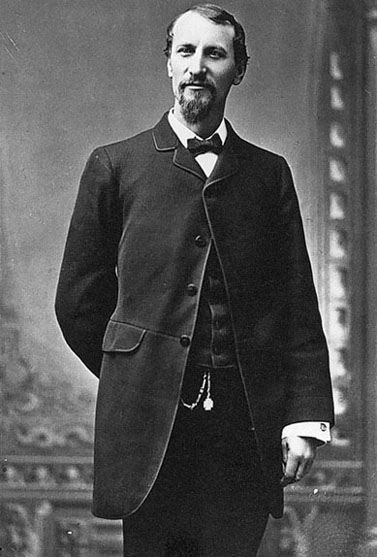
Harvey died in 1901, and at the time of his death his financial empire included 45 restaurants and 20 dining cars, in 12 states. His sons and grandsons continued his brand and further developed “Harvey Houses” that offered accommodations and fine dining. They opened several at the Grand Canyon and in the early 1900s the Fred Harvey Company created an “Indian Department” which commissioned artists, such as Hopi Artist, Nampeyo of Hano (the first Pueblo artist with national recognition), and hired photographers to go to the Pueblos and shoot stylized shots for advertising use, internal menu design, and marketing collateral to promote the businesses.
The company also employed Native Americans to have live demonstrations for rug weaving, pottery, jewelry making, and other crafts at his Southwest hotels. The sales of those items in Harvey’s stores influenced the design of native arts tremendously.
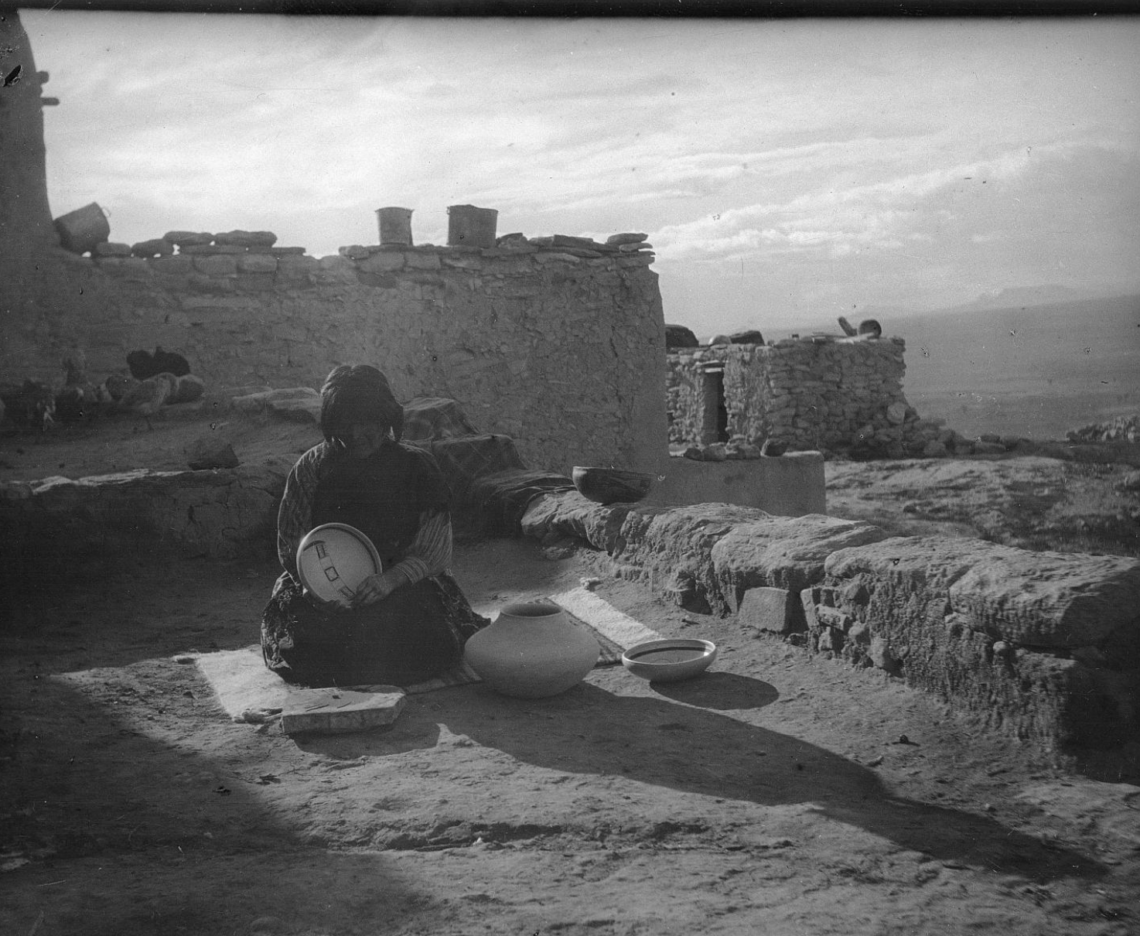
In the 1926, the Harvey Company began to offer “Indian Detours” whereby guests could board “Harvey Cars” and visit Native pueblos, and historic sites.
Initially, Harvey provided comfort when the West was still considered “wild.” Together, the Santa Fe Railroad and the Fred Harvey Company had a profound and transformative impact on the image of the American Southwest that transformed it from wild and savage to Santa Fe Chic, attracting visitors to the Southwest such as President Teddy Roosevelt, Albert Einstein, The Shah of Iran, and countless movie stars and bon vivants from around the world.

While the elite adopted New Mexico’s native population romantically, the natives continued to suffer in poverty, forced into attending boarding schools, land grabs and disputes, and “Christian” demands of enculturation of the Native people. People who had lived for over 14,000 years in the area in harmony with nature, now drug into the demands and pressures of an economic system engulfing them further every decade to become citizens of the United States of America, and eroding, and often destroying, their own distinct cultures.
Land
Before European settlers arrived, the Native people occupied 1.9 billion acres of land, with a completely different concept of ownership. At contact, North America was home to more than 50 language families, comprising between 300 and 500 languages.
In the state of California alone, there were an estimated 100 different tribes with more than 200 spoken dialects.
[Sidebar: As of 19 February 2020, the Bureau of Indian Affairs (BIA) of the United States legally recognized 574 Indian tribes in the entire nation.]
Needless to say, many tribes and languages have been lost. The Federal governments land policies created huge loss of tribal lands, often forcing smaller tribes to vanish, or assimilate with other tribes.
Perhaps one of the most devastating federal policies other than the Indian Removal Act of 1830, was the General Allotment Act of 1887.
In 1871, Congress declared that no further treaties would be made with Native People, and all future dealings with Indians would be conducted through legislation.
Individual ownership of private property was viewed as an essential part of “civilization” that would give Indian people a reason to stay in one place, cultivate land, disregard the cohesiveness of the tribe, and adopt the habits, practices and interests of the American settler population.
Ambitious Americans felt that Indian people had too much land, and they were eager to see Indian lands opened up for settlement, as well as for railroads, mining, forestry, and other industries.
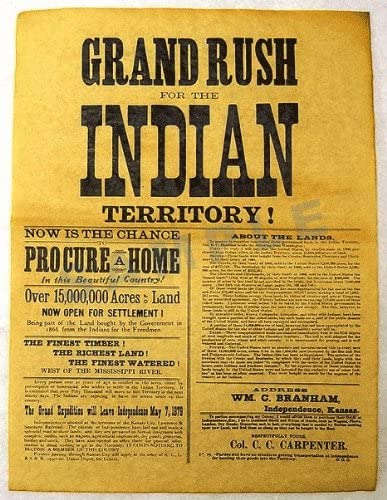
The proposed solution was to give members of a selected tribe, or reservation, permission to select pieces of land, usually around 40 to 160 acres in size, for themselves and their children. Or, an agency superintendent would assign the individual allotments. It’s important to remember, that the concept of land ownership, so prized by the European, was absolutely thought meaningless and absurd by the Native Americans.
After the land was allotted, if the amount of reservation land exceeded the amount needed for allotment, the Federal Government was able to negotiate the purchase of the land from the tribes, and sell it to non-Indian settlers.

The General Allotment Act caused Indian land holdings to plunge from 138 million acres in 1887 to 48 million acres by 1934, when allotment ended. Native people are still trying to recover lands.
Today, the U.S. Federal Government holds 56 million acres of reservation land, currently under “Indian ownership” in trust for Native American people.
In 1863, in the middle of the American Civil War, President Abraham Lincoln presented New Mexico’s 19 pueblos with silver-headed canes as a symbol of the Federal Government’s recognition of their sovereignty.

In the 1920s, the All Indian Pueblo Council gathered for the first time in more than 300 years. Responding to congressional interest in appropriating Pueblo lands, the U.S. Congress passed the Pueblo Lands Act in 1924. The Acoma were able to maintain much of their land.
However by 1922 a majority of the children were forced into boarding schools, and made to speak English, and practice Christianity. As a result, today there are only approximately 100 fluent native speakers in Acoma. Several generations of Acoma people have been cut off from their cultural education, as well as other Pueblo tribes. The Pueblo people have a very sophisticated spiritual cosmology that takes a lifetime to learn. If the young are cut off from their elders and ceremonies, all of the complex teachings, oral traditions, and rituals are lost.
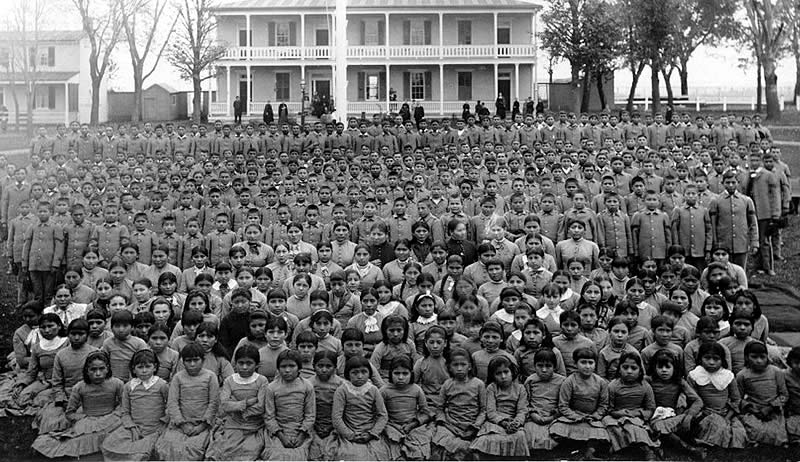
Moreover, the Pueblo people traditionally are corn farmers in a region with only 10-12” of annual rainfall. Many of their spiritual relationships are expressed in the cycle of farming and prayers for rain. Land and water is regarded among the Puebloeans as their most precious resource. After the Federal government permitted companies to mine for uranium, creating over 500 mining waste disposal sites, the Acoma were forced to stop traditional farming due to the contamination from mining operations of the only surface water in the area, the San Jose River.
Savages
One of the last Indian tribes to wage war on the Americans occurred in the Southwest with the Apache leader, Geronimo, medicine man, captured in 1886. Most Americans knew nothing of the Apache tribe or customs, simply that there was a very stealthy leader causing a big stir in the Southwest.
Most of the general American public at that time in our history, held the collective consciousness that all native men were warriors, savages with bow and arrows, tomahawks, and a desire to scalp non-natives. Simply not true!
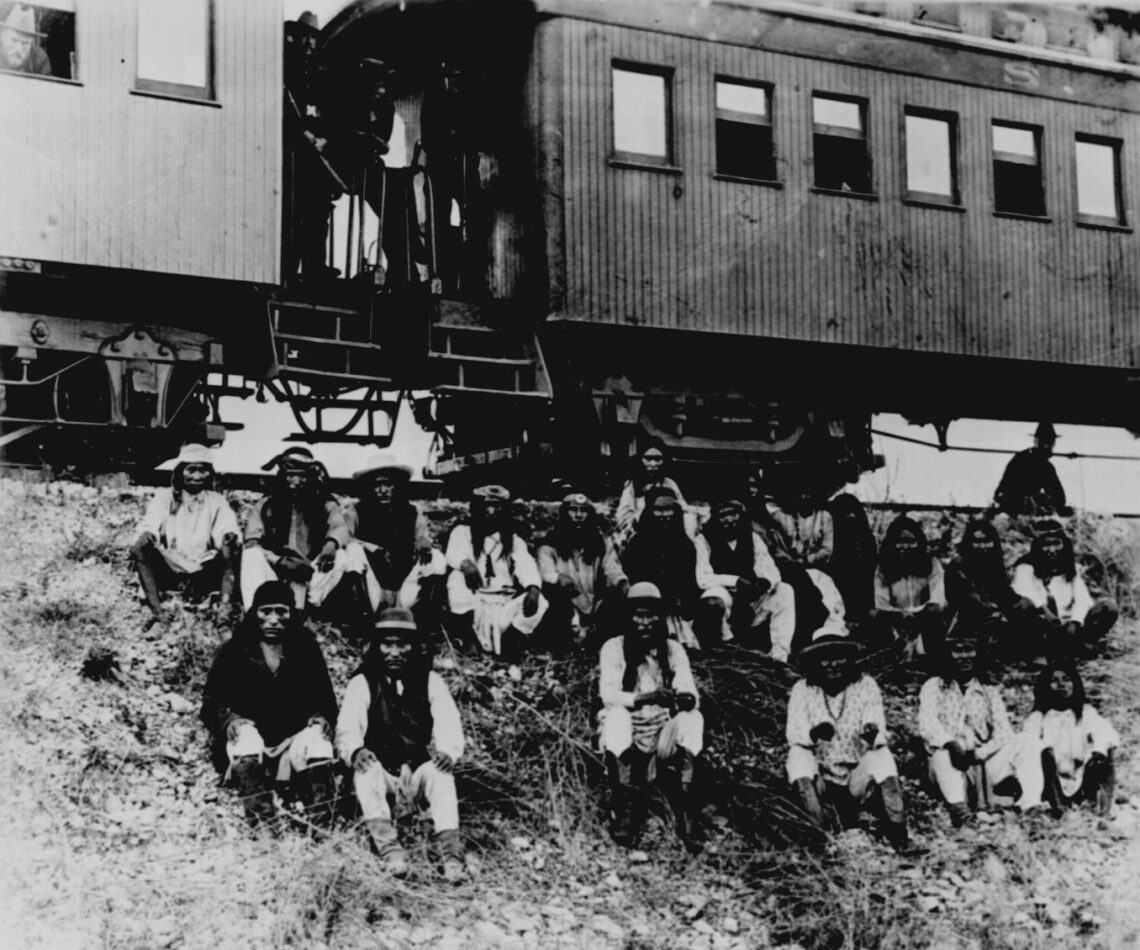
Today, I think it’s difficult for many Americans to realize the level of racism and misinformed ideas held about Native Americans in this country. The best source I have found to illuminate this fact is from a documentary film made in 1992, narrated by actress Helen Hunt, entitled, “Ishi, The Last Yahi.”
The film documents a tragic, and true story of a man discovered on a ranch in Northern California in 1911, who was the last Yahi of his tribe, who had been alone in the wilderness trying to survive, in spite of paid bounties having killed his entire family, the going rate .50 for a scalp, and $5 for a head. The Federal Government reimbursed over $1 million dollars to the state for bounties paid to murder native people.
The newspapers writing of his discovery used adjectives like savage, aboriginal, and wild man. One paper said, “The tale more firmly confirms the belief that the Indian is the least civilized man in the United States, and the last surviving members of the Deer Creek Indians the most uncivilized Indian band in America.”
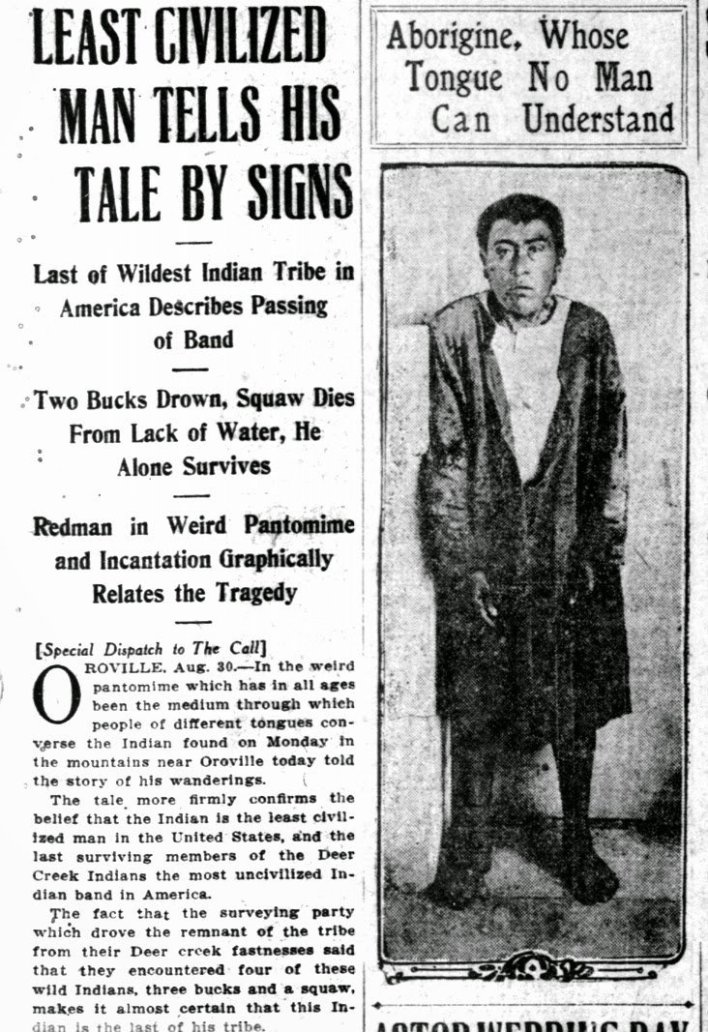
Hollywood Indians
The 1920s was very impactful year for the Acoma people. Hollywood came to Acoma to film “Redskins,” a silent film made in 1929, staring non-Indian Richard Dix and non-Indian actress, Julie Carter. They built the first road to the Pueblo to enable filming on location at the Pueblo.
The movie is the first Hollywood production that attempted to view the Native Americans of the Southwest in a sympathetic light, albeit filled with the racist ideas and behaviors one would expect from the time period. Although the main actors were non-native, the extras were from the Acoma Pueblo and Navajo reservation.
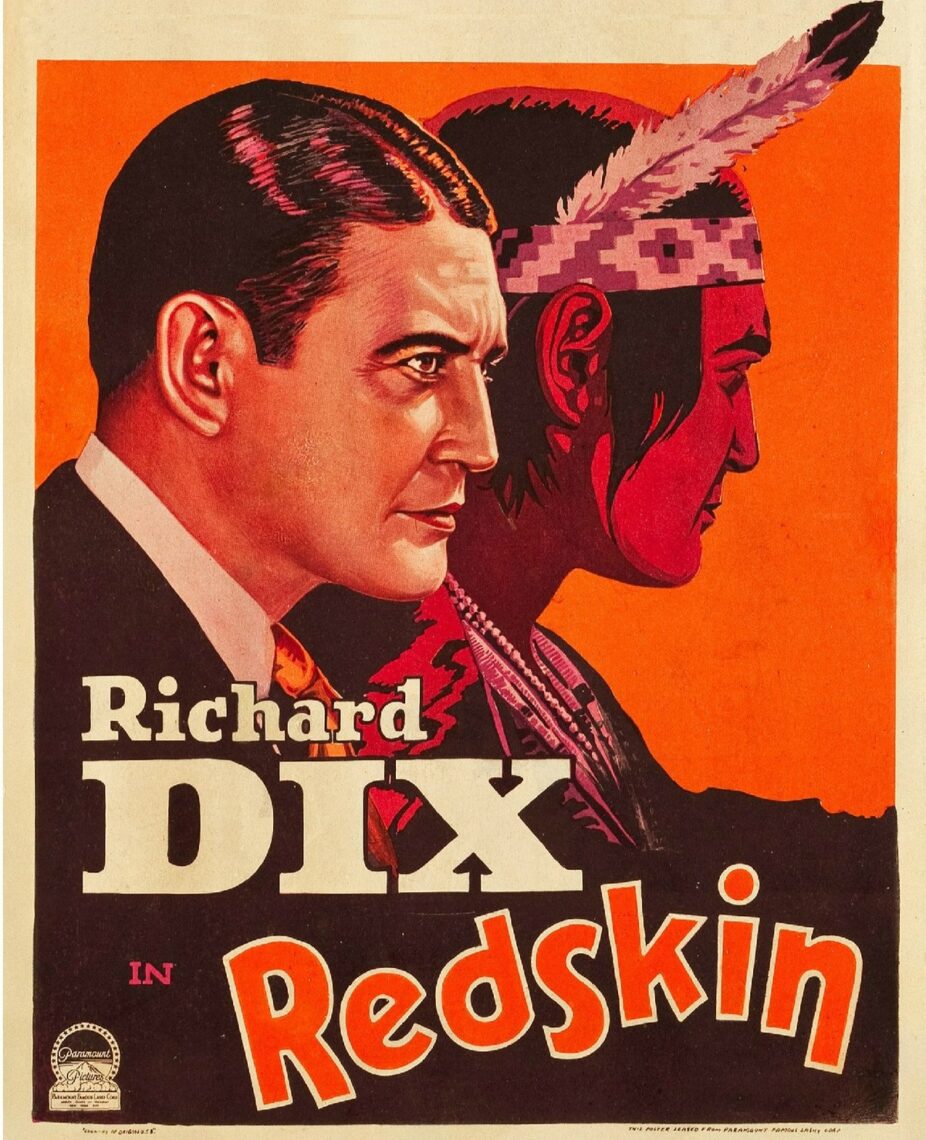
The romantic association with Acoma of Hollywood certainly would have been good for sales in Santa Fe. Interestingly, this is a time in which dealers in the area begin to try and influence Native American potters. In 1922, another outside force influenced the Pueblo artisans. The Santa Fe Indian Fair, designed to showcase the quality of the Native American art. Instead of a wagon full of random pottery, the dealers wanted their “best” work and incentivised the artists by paying more for pieces deemed of a certain quality.
Also, the same year, collectors and scholars in Santa Fe joined to create, The Indian Arts Fund to collect and preserve important examples of Native American arts of the Southwest.
Main Street of America
In 1926, Route 66 was completed connecting Chicago to Los Angeles. This became the gateway for car travel from Chicago to Los Angeles. Needless to say, an opportunity for service related businesses to open along the way, and the birth of the Roadside Trading Post.

The Acoma Pueblo’s northern border assured a passersby might be a potential customer for their pottery, and certainly for the many tourist shops that dealt in “authentic Indian made” products.
It also had a “pawn” role for the native people that acted as moneylender, safety deposit, and marketplace. The “live pawn” allowed them to safely get some cash and safeguard important family possessions. The “dead pawn” gave the storeowner a chance to recoup their loan and make a profit. The relationships with dealers could be multi-generational and very personal.
According to one owner, Mr. Richardson, who’s family owned and operated their store on Route 66 for 100 years, they had stores on the Indian Reservations until the 1930s, and then the Indians took the stores back and pushed them off the reservation.
In the 1930s, traders and promoters began to encourage artists to sign their pots, to both distinguish the artist and promote collecting. This didn’t really become widespread until the 1950s.

Koyaanisqatsi
By the 1960s, the Acoma pottery had to meet the demands of an ever-growing tourist market, and many potters began to use commercial slip-cast “greenwares” (ready-made smooth surfaces), and firing the pottery in a kiln, forgoing the difficult traditional and time-consuming method. Also, we see more male potters entering the Acoma arts. Traditionally, Acoma women made the pottery.
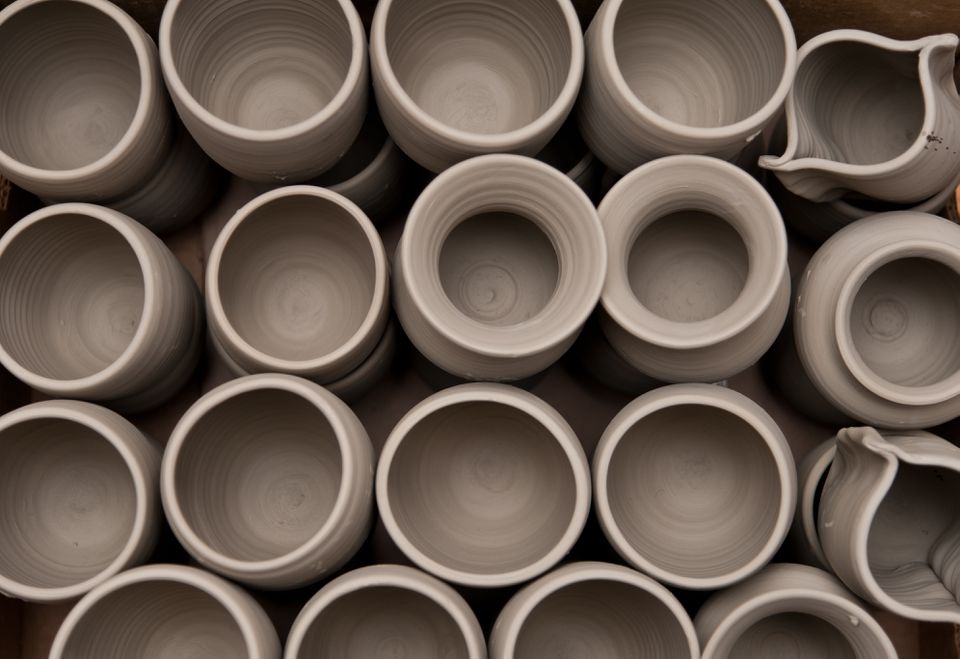
The designs began to become more intricate, and complicated, but lacking the traditional spiritual soul. Like all things, when commercial output demands prevent the time and personal connection to the art and the natural materials once harvested locally—something precious is lost.
Of course, some contemporary Acoma artists are trying to retain certain traditions, but many are using the kiln, or commercial paint due to the time constraints of living in a modern American lifestyle.
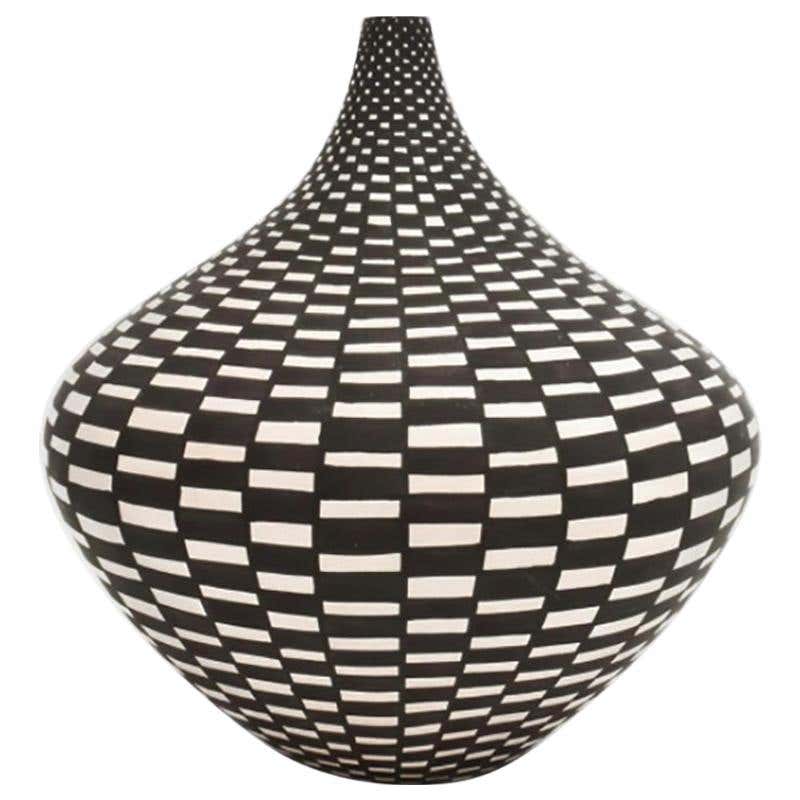
The Pueblo People continue to face problems: land disputes, forced re-locations over mineral rights, (research the Peabody company’s coal operations), socio-economic disparity, alcohol and drug addiction, teen suicide, elders dying of Covid-19: endangering the treasure chest of knowledge and language, and many other contemporary problems facing the people of any city in today’s world.
In the face of such challenges, I truly hope the young Acoma artists, and other native tribes in this country will continue to embrace the extraordinary creative process given to them by their ancestors.
After I did the research for this article, I felt sick for several days. I felt that perhaps I shouldn’t own the pottery. It felt like blood-diamonds. But after searching further, I realize that they are symbols—personal testimonies—to each woman’s strength of character, adaptability, and patience. Their undeniable contribution to art, culture, and a voice to the world—We shall remain in the place prepared.
Spiritual Creation
I have intentionally left how traditional Acoma pottery is made to be my last comments, because this is precisely the beauty and power of the art…the holy catharsis that makes Acoma pottery some of the most special works of art in the world.
Before the potter began, she would say prayers to Mother Earth, and asked her to give her material.
Elders would have shown her where to harvest the clay, and she would have learned how to make it from her mother or grandmother. She would descend 365 feet down from the mesa to retrieve it. Once collected, she placed the clay in a blanket to return.
The clay must be sun-dried first. Then she must add rainwater to clean it. It must be rainwater. Then she soaks the clay. It creates curdled pieces. She soaks it a second time, lets it dry, and then she grinds the clay on the metate (Volcanic stone from El Malpais). She then gathers old, and sometimes ancient, pottery sherds and soaks them for three or four days to soften, and then dried, and grinded to the consistency of flour.
Old, often ancient, broken pottery pieces were used for temper to strengthen the pottery, and to lessen the chance of cracking, or breaking when fired. During the grinding process, more prayers are offered.
She adds up to equal amounts of ground pottery sherds with the clay and adds water. This mixture is allowed to mature for several days. After resting, the mixture is kneaded by hand (or foot) to improve plasticity, and to remove air bubbles.
The potter makes a small pancake from the clay and presses it into a huudiitsi, a shallow concave mold, often the bottom of a broken vessel, whose rim is ground down to create a smooth edge. She then creates rope coils, and begins to build the new pot laying coils.
It is time consuming, and takes tremendous patience and skill. The huudiitsi allows the potter to slowly turn the vessel as she builds it. When the pot is built, it is allowed to dry to “leather hardness” and it is removed. The potter builds from the inside, and up. She can allow no air-bubbles, or it will explode!
Now dry, the surface is moistened, and scraped to thin the side walls and smooth the surface: In the 1920s a knife, rough stone, or baking powder tin was used for the job. Later corned beef cans, or Skoal can tops!
Then a white or cream slip was added to the top of the vessel, made from nearby white clay, to act as a gesso and create a blank canvas for her to paint. Other slip colors were used, but white was the dominant color. The white clay was also ground to a powder, and water was added to make the slip coating. Once you let the slip dry, you don’t put water back on it, or it will crack!
The brush used to apply pigment was made from the Yucca plant. The big leaf steams, largest end, was chewed until the tough fibers separated. Creating different size “brushes” based on the requirement of the application.
The bottom was red fired, as well as the interior top portion of the pot.
Before the slips dried, both the white and red slip, are rubbed gently with a smooth stone to polish the surface. Then, she adds framing lines to the under-body and the top.
She then marks out the design. Carbon was used in the early 1900s because carbon lines easily burned off during firing.
The paint was derived from gathering natural mineral resources. The color black was made from collecting local iron ore which had manganese, and rubbed with a rock to make a powder, often combined with a syrupy, thick material derived from boiling wild spinach (also called, Rocky Mountain bee weed, or Cleome Serrulata). Orange and red was also made from minerals found locally, and ground to a powder.
After the design was drawn and painted, the pottery was taken to a protected location from the possible strong winds (often back down from the mesa), and placed over the ashes of a warm fire that dried and warmed the earth, also warming the pottery. The potter covered the smaller pieces with large pieces of broken pottery. Dried sheep dung was pilled on top forming a large mound, creating a primitive kiln. After the dung burned, the pottery is removed, still hot to the touch. Not all of her work will make it through. She could have invested many hours of her work, and originality in design and painting, and have it break in the fire.
When finished, the pots are hard and stable, but they are also slightly porous, which allowed the escaping moisture to cool the water.
When the pottery is finished, it is an expression of a woman’s unique vision and artistic expression. She has gathered the fruits of Mother Earth and transformed them into an expression of gratitude and function: to hold her most cherished resource—water—which as a people ensures crops will live, children will grow, the circle will be complete, and life will continue, just as it has since the beginning of time.
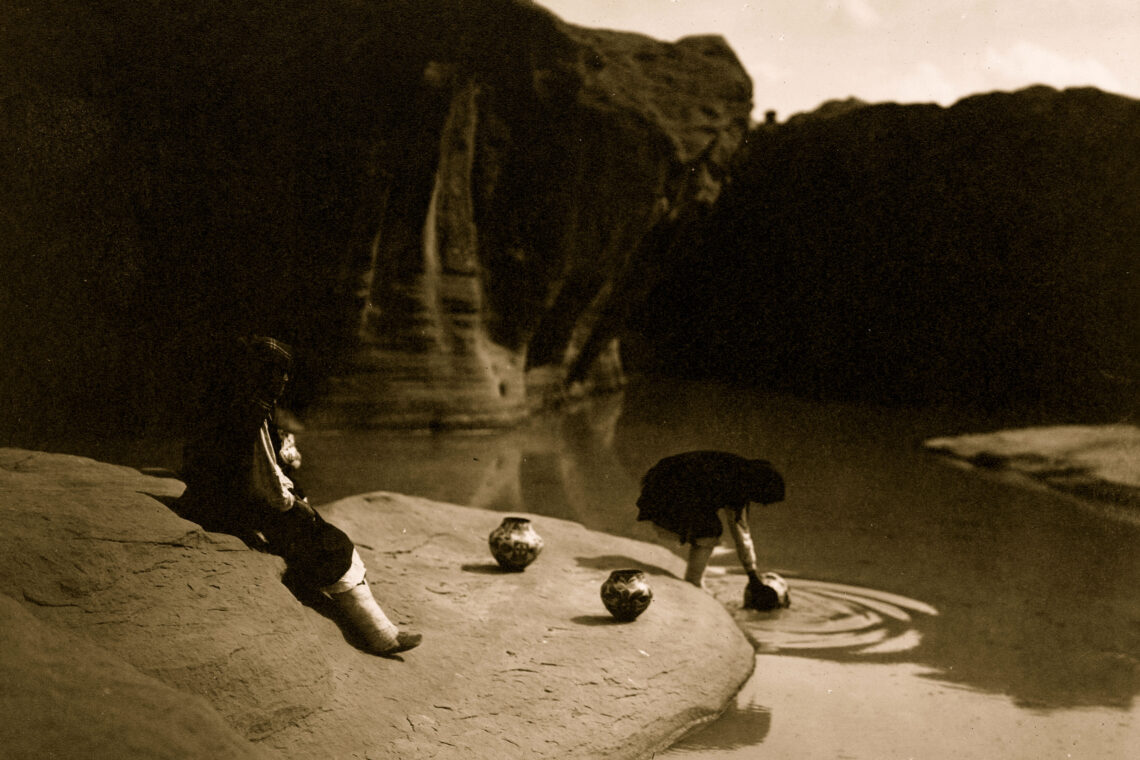
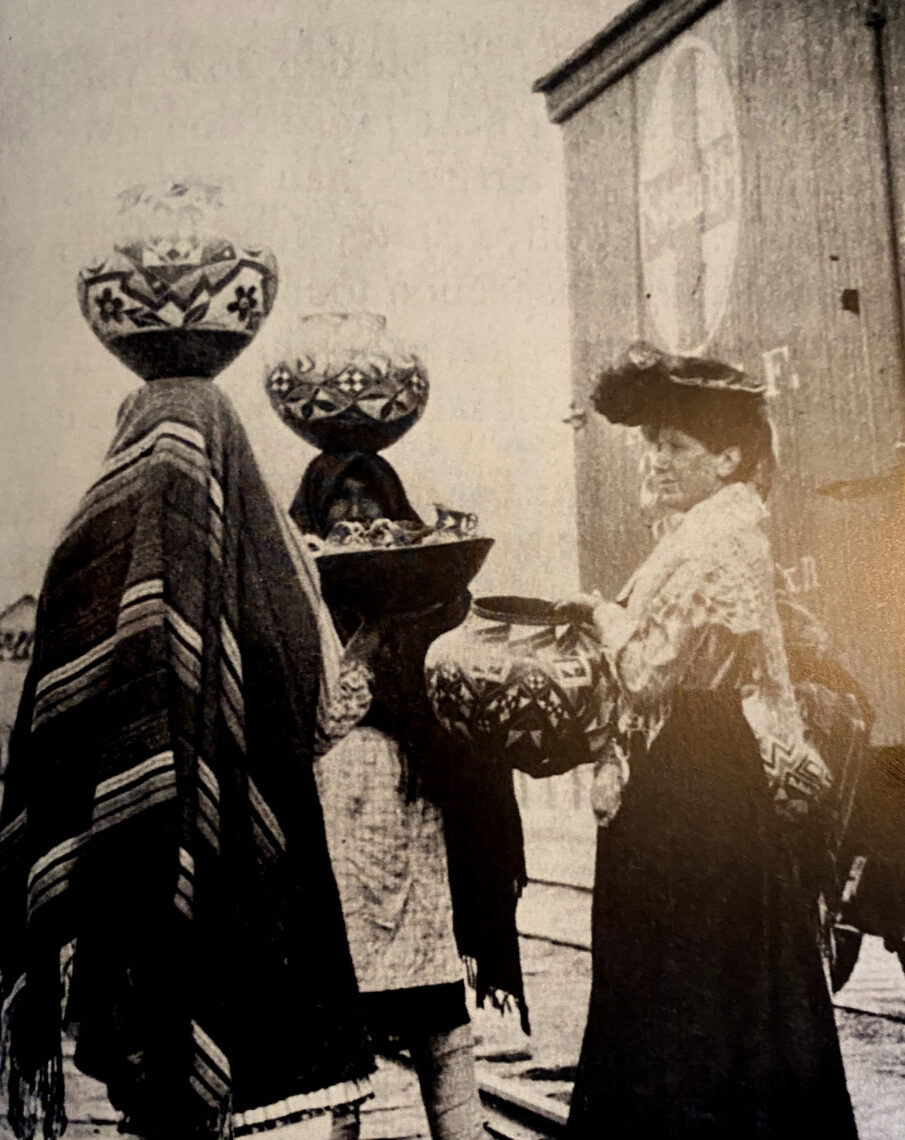
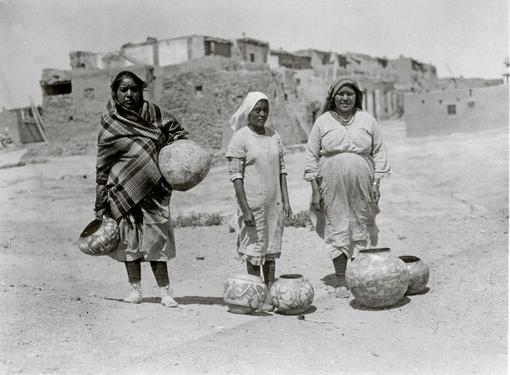

Special thanks to: Dwight P. Lanmon and Francis H. Harlow, authors of The Pottery of Acoma Pueblo, Video: Emergence: Acoma Sky City Cultural Center, Smithsonian Institution for photo images, Margaret D. Jacobs, Indian Boarding Schools in Comparative Perspective: The Removal of Indigenous Children in the United States and Australia, 1880-194. The Business of Culture at Acoma Pueblo, authors: Regina Gilbert, MBA and Helen J. Muller, Ph.D., ATADA (Antique Tribal Art Dealers Association), History.com, Stanford News (Stanford University), and Britannica. Thanks to the Library of Congress, Wikipedia, and The Daily Beast. The Santa Fe New Mexican, The New York Times, NPR (National Public Radio), Professor of History, William Fitzhugh Brundage, The Indian Land Tenure Foundation, and the Palace of the Governors in Santa Fe.